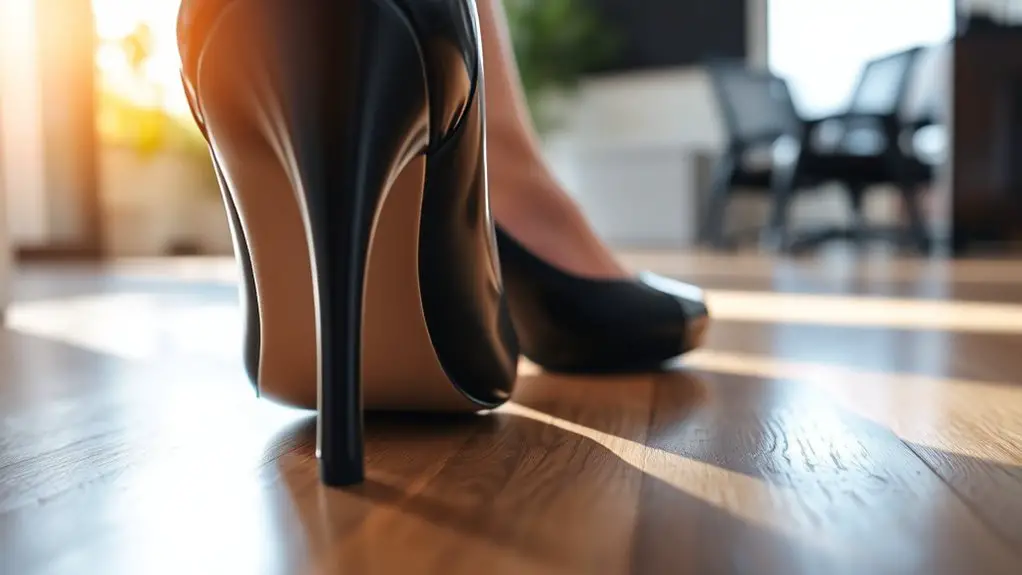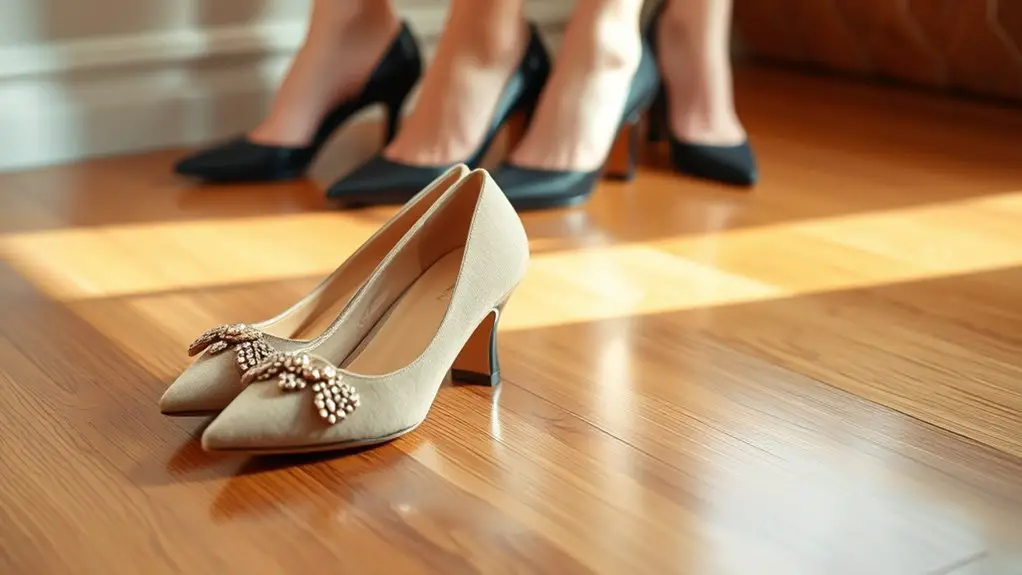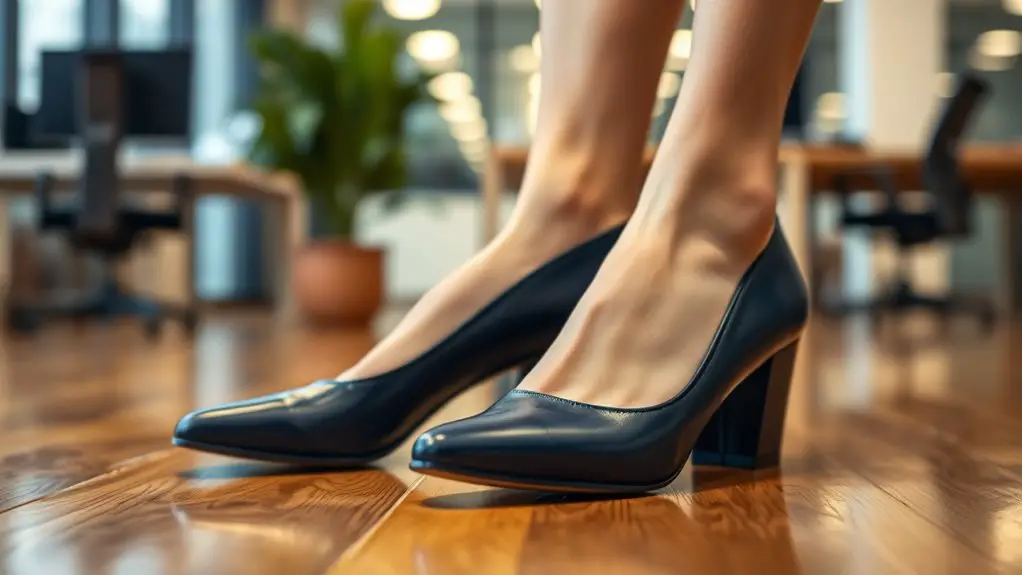If you’re standing all day at work, opt for heels with excellent arch support and advanced cushioning to reduce strain and fatigue. Look for styles with lower, wider heels for stability and a snug fit to guarantee comfort. Materials like memory foam and breathable fabrics enhance wearability. Aim for moderate heel heights of 2 to 3 inches for a blend of elegance and comfort. Continue exploring to find the best options tailored to your needs.
Understanding the Importance of Comfort in Heels

When you’re on your feet all day, the right pair of heels can make all the difference, as comfort directly impacts your productivity and well-being. Prioritizing foot health is essential; discomfort can lead to foot fatigue, blisters, and long-term issues. When choosing heels, consider styles that provide proper arch support. This support distributes your body weight evenly, reducing strain on your feet and back, allowing you to maintain energy levels throughout the day.
Additionally, heels with cushioned insoles can absorb shock, further enhancing comfort during long hours. A shoe’s construction should promote stability, preventing your feet from sliding forward, which can cause pain and misalignment. Remember, your choice of heels isn’t just about aesthetics; it’s about making smart decisions that benefit your health in the long run. By investing in comfortable heels with adequate support, you’re setting yourself up for success both at work and beyond.
Key Features to Look for in All-Day Heels
Choosing the right pair of heels for all-day wear hinges on a few key features that can dramatically enhance your comfort and support. First, look for excellent arch support. This feature helps distribute your weight evenly, reducing strain on your feet and lower back. Heels without proper arch support can lead to fatigue and discomfort over time.
Next, pay attention to cushioning technology. Opt for shoes that incorporate advanced cushioning materials, as they absorb shock and provide additional comfort. This kind of cushioning can make a significant difference, especially if you’ll be on your feet for hours.
Additionally, consider the heel height and width; a lower, wider heel can offer better stability. Finally, make certain the fit is snug but not too tight, allowing your feet to breathe. By focusing on these features, you can find a pair of heels that keeps you comfortable and stylish throughout your busy day.
Top Brands Known for Comfortable Heels

While the quest for the perfect all-day heels can be challenging, certain brands stand out for their commitment to comfort and style. One such brand is Clarks, known for their innovative comfort technology that combines cushioning with classic designs. Their brand reviews consistently emphasize the balance of support and elegance. Another favorite is Naturalizer, which focuses on creating heels that fit a woman’s foot properly. Their signature N5 Comfort System guarantees you’ll be comfortable throughout your workday. Additionally, Cole Haan is celebrated for integrating athletic shoe technology into their heels, providing extra shock absorption and flexibility. Finally, Vionic’s heels offer built-in arch support, making them a go-to for those who prioritize foot health. Exploring these notable brands can help you find stylish options that won’t leave your feet begging for relief.
Stylish Heels for a Professional Look
When choosing stylish heels for a professional look, comfort is key, especially heel height. Opt for a moderate height that provides support without sacrificing elegance. Additionally, versatile color options can elevate your outfit while ensuring you remain polished and ready for any work scenario.
Comfortable Heel Height
Finding the right heel height can make all the difference in your comfort and style during long workdays. Opting for heels between 2 to 3 inches strikes a balance between professionalism and foot health. Here’s a quick guide to help you choose:
| Heel Height | Comfort Level | Best For |
|---|---|---|
| 1 inch | High | Casual settings |
| 2 inches | Moderate | Office environments |
| 3 inches | Acceptable | Formal occasions |
| 4 inches | Low | Special events |
| 5+ inches | Very Low | Occasional wear |
Consider these guidelines to guarantee you maintain comfort without sacrificing your professional look. Your feet will thank you after a long day!
Versatile Color Options
Choosing the right heel height is just one aspect of creating a polished look for the workplace; color also plays a significant role. Understanding color psychology can enhance your professional image, while keeping seasonal trends in mind guarantees you’re stylish year-round. Here are four versatile color options for your work heels:
- Classic Black: Timeless and sophisticated, perfect for any outfit.
- Nude: Offers an elongating effect on the legs and matches various attire.
- Navy Blue: A chic alternative to black, providing a touch of personality.
- Burgundy: Great for fall and winter, adds warmth without being too bold.
Incorporating these colors into your wardrobe will help you maintain a professional yet fashionable appearance throughout the day.
Recommended Heel Heights for Comfort

Although it might seem tempting to opt for high heels for a touch of elegance, the recommended heel height for comfort typically falls within the range of 1 to 3 inches. This height strikes a crucial comfort balance, allowing you to maintain proper posture without straining your feet or lower back. Heels in this range provide adequate elevation while distributing your weight more evenly, reducing pressure points.
If you’re on your feet all day, consider a block heel or a wider base for added stability. In contrast, heels above 3 inches can quickly lead to discomfort, fatigue, and even long-term foot problems. Remember, prioritizing comfort doesn’t mean sacrificing style; many fashionable options exist within this height range. When shopping, always try on heels to guarantee they fit well and provide the support you need for your busy workday. Your feet will thank you!
Materials That Enhance Comfort in Heels
The right materials can make all the difference when it comes to comfort in heels. You’ll want to look for features that support your feet throughout the day. Here are four materials that enhance comfort:
- Memory Foam: This material molds to your foot shape, providing cushioning that alleviates pressure and reduces fatigue.
- Breathable Fabrics: Look for shoes made with mesh or other breathable materials to keep your feet cool and dry, preventing discomfort caused by sweat.
- Soft Leather: High-quality leather can conform to your foot over time, offering a balance of support and flexibility.
- Gel Padding: Integrated gel inserts can absorb shock and provide additional cushioning, making long hours on your feet much more manageable.
Investing in heels made from these materials can greatly enhance your comfort, allowing you to focus on your work rather than your aching feet.
Tips for Breaking in New Heels
When you bring home a new pair of heels, it’s vital to break them in properly to prevent discomfort during long workdays. Start with gentle breaking techniques; wear your heels around the house for short periods. This allows the heel materials to flex and mold to your feet without overwhelming pressure.
You can also use thick socks and a hairdryer to gently heat the areas that feel tight, softening the material and encouraging a better fit. For leather heels, consider applying a leather conditioner to enhance flexibility.
If you’re facing particularly stubborn areas, try using a shoe stretcher overnight to ease any pressure points. Remember to alternate between different pairs during the week to give your new heels a break while they adjust. This thoughtful approach will guarantee your heels are comfortable and ready for those long hours at work.
Caring for Your Heels to Extend Their Lifespan
Properly breaking in your heels is just the beginning; maintaining them is key to ensuring they last. By following these heel maintenance tips, you can effectively prolong your shoe lifespan and keep them looking fresh.
- Clean regularly: Wipe off dirt and scuff marks with a soft cloth. Use appropriate cleaners for specific materials.
- Store properly: Keep your heels in a dust bag or shoe box to protect them from scratches and sunlight.
- Rotate your shoes: Avoid wearing the same pair every day. This gives the materials time to recover and reduces wear.
- Use protective sprays: Apply water and stain repellent to shield against spills and moisture, especially for suede and fabric heels.
Frequently Asked Questions
Can I Wear Heels if I Have Foot Problems?
If you’ve got foot problems, wearing heels might worsen your foot pain. Consider heel alternatives like supportive flats or wedges that provide comfort and stability, helping you avoid further complications while still looking stylish.
How Can I Prevent Blisters When Wearing Heels?
To prevent blisters when wearing heels, prioritize blister prevention by using heel cushioning. Consider silicone pads or gel inserts, and guarantee your shoes fit well to reduce friction. Regularly check for irritations during wear, too.
Are There Specific Heel Types Better for Arch Support?
When considering arch support types, look for heels with cushioned insoles, contoured footbeds, and wider heel bases. These heel design features can enhance comfort, reduce fatigue, and provide the support you need throughout the day.
What Are the Best Insoles for Added Comfort in Heels?
For added comfort in heels, consider insoles made from cushioning materials like gel or memory foam. Look for options that provide arch support to alleviate pressure, ensuring your feet feel better throughout the day.
How Often Should I Replace My Work Heels?
“Don’t put off till tomorrow what you can do today.” You should replace your work heels every 6-12 months. Regular work shoe maintenance and following heel longevity tips can help maximize their lifespan and comfort.



